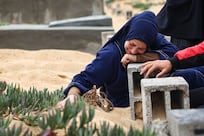I had the pleasure of reading your article about the official logo for the UAE Year of Tolerance. I work in a nursery in Abu Dhabi, in Khalifa City A, called Little Smarties, which has has a very special connection with the ghaf tree.
This tree offers nourishment in the UAE desert, just as Little Smarties nursery nourishes our young students’ education through creative play and a pathway to their future educational journey.
As a result, we have a big drawing of a ghaf tree in our activity room, drawn by our talented staff nine years ago.
Name withheld by request
Racism must be weeded out of Tunisian society
With reference to your editorial Tunisia's anti-racism law proves commitment to ending discrimination (February 10), despite the world being so advanced in every aspect, words such as racism and slavery still echo in society. It is quite shocking that racial minorities still face discrimination in Tunisia, which abolished slavery a long time ago.
The situation highlighted by Mnemty, an anti-racism group, reminds us that such incidents continue to happen in the country. It shows that the country needs to further strengthen its policies and actions should never be delayed or compromised.
The reality is that the issue is deep-rooted. It needs to be weeded out and prevented from flourishing further. With a diverse mix of people living together, a different outlook must prevail to ensure everyone feels comfortable and at home. Proper education and humanity can help root out problems.
Ramachandran Nair, Muscat
What’s bad for the goose is bad for the sturgeon
With reference to the discussion on the ethics of eating foie gras (As New York moves to ban foie gras, should the UAE be next? February 5), might I suggest that we also reconsider eating caviar as well, particularly in the light of several unnatural ways used for its extraction.
These should be appropriately addressed, either by education or an outright ban. We should remember that meddling with nature has consequences.
Mohammad Hamza, Dubai
![RAS AL KHAIMAH, UNITED ARAB EMIRATES - September 24: The ghaf tree forest near the Digdagga area of Ras Al Khaimah on September 24, 2008. The ghaf tree is an indigenous tree which grows in the flat sandy plains of the UAE deserts. Its very long roots ensure it can reach water from deep within the ground allowing it to survive in the hot desert conditions. (Randi Sokoloff / The National) Prosopis africana. Prosopis cineraria is a species of flowering tree in the pea family, Fabaceae, that is native to arid portions of Western and South Asia,[1] such as the Arabian[2] and Thar Deserts.[3] Common names include Ghaf (Arabic),[1] Khejri, Jant/Janti, Sangri (Rajasthan), Jand (Punjabi), Kandi (Sindh), Banni (Kannada), Vanni (Tamil), Sami, Sumri (Gujarat). It is the provincial tree of the Sindh province of Pakistan. Prosopis cineraria is a small to medium-sized thorny tree, with slender branches armed with conical thorns and with light bluish-green foliage. The leaflets are dark green with thin casting of light shade. It coppices profusely.
The tree is evergreen or nearly so. It produces new flush leaves before summer. The flowers are small in size and yellow or creamy white in colour, appear from March to May after the new flush of leaves. The seedpods are formed soon thereafter and grow rapidly in size, attaining full size after about two months.
It is well adapted to browsing by animals, such as camels and goats. Young plants assume a cauliflower-like, bushy appearance in areas open to goat browsing.
Prosopis cineraria requires strong light, and dense shade will kill seedlings. The crown (aboveground portion) grows slowly.
The root system of Prosopis cineraria is long and well developed, securing a firm footing for the plant and allowing it to obtain moisture from groundwater. Taproot penetration up to 35 m (115 ft) in soil depth has been reported. Like other members of the family Fabaceae, symbiotic bacteria found in its root nodules allow it to fix nitrogen in th *** Local Caption *** RS031-GHAF.jpgRS031-GHAF.jpg](https://thenational-the-national-prod.cdn.arcpublishing.com/resizer/v2/IUSRY4YSXAAYMMQI5NNJYWORZI.jpg?smart=true&auth=2cf6aaa7d0b33920608f36fe825f1c2ad48c6d6eed0131da511316b5b05c6619&width=800&height=542)




